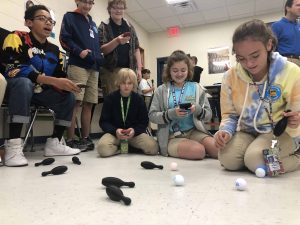The Chevron Fuel Your School Program helps public school teachers in grades K-12 fund classroom projects. The program is part of Chevron’s overall support for education. Since 2013, they have donated over $400 million worldwide to help provide teachers with the tools to prepare students for the jobs of the future. Chevron believes that effective education, including Science, Technology, Engineering, and Math (S.T.E.M.) will foster bright talent for the future workforce, as well as a healthy economic growth for the country. The Project Funding Period begins on October 3 and ends on November 3, or until the maximum Chevron donation amounts for that participating area have been exhausted or all funds have been distributed within the city that the funds were earned. Eligible classroom project requests will be funded on a rotating basis by the order in which they are received and posted on DonorsChoose.org per eligible school within each city. Teachers have until 11:59:59 pm EST on October 31, 2018 to submit their projects.
How does the Fuel Your School Program work? During the month of October, when you fill up with 8+ gallons at a participating Chevron or Texaco station in Jackson County, Chevron will donate $1 to help fund eligible classroom projects in the local community. One of the recipients of the Chevron Fuel Your School Program is Julie Massey, a teacher at St. Martin Middle School, whose students are working with robots. “I am so excited about this program. These sphero robots, I’ve never seen anything like it before. We plug them in and basically take a cell phone and the kids write their own apps. So they’re actually coding. And then they shoot it to the robot and the robot just does exactly what they want it to. This is hands-on instant gratification coding. And without Chevron, we couldn’t have this.”

“You just decide what you want first, then write it down and then you turn it in. What have you got to lose? Put yourself out there. Go on ahead and apply for something and if you need it for your classroom, make it happen.” Nolan Brechtel, one of Massey’s students, is learning a lot with the robots. “I’m learning how to use JavaScript to program the robots rather than the block code that everybody else is using.” He agrees that the program is a good one, and that by donating the robots, Chevron is helping not only the class, but their futures.
“It gives more people an opportunity to learn how to program and to be able to use robots that they might not be able to use at home. It’s helping everybody learn how to program for the future just in case they want a job like that.” Brechtel isn’t sure yet what he wants to do when he leaves school but says he’s leaning towards being a pilot.
By utilizing the program, and receiving the funding, it gives the students and teachers a chance to allow the students to think creatively and then make it happen. “You have the heart brain, the head brain and the gut brain. A passionate idea starts in your heart and it goes to your brain and you figure out what to do with it. But it can die right there unless there are resources to make it happen. Otherwise it’s just an idea. Imagination is one thing, but creativity is when it actually happens.” Amacker is grateful to Chevron for their contribution in making this all happen, and states that “it’s really been powerful.”
For more information about the Chevron Fuel Your School Program, visit www.fuelyourschool.com.